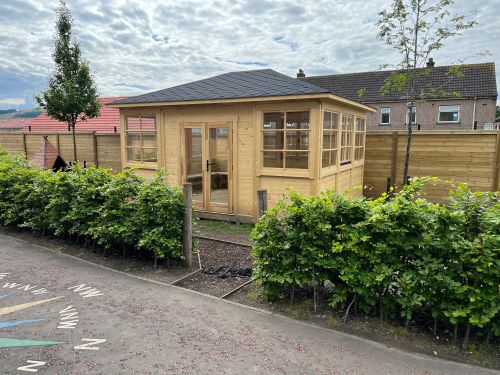When most people think of the word “classroom,” they imagine a room with four walls and a chalkboard. However, there are other types of classrooms out there! One example is an outdoor classroom. Outdoor classrooms can offer many benefits to students, such as improved physical health, better academic performance, and enhanced creativity. This blog post will discuss the top 10 lessons for an outdoor classroom!

1. Be Organized
Outdoor classrooms can be a great way for students to learn, explore and engage with the environment. To make sure that students get the most out of their outdoor learning experience, it is important to ensure that materials are organized and orderly so students can easily access them. This means clearly labeling items and storing them in an easily accessible area. Additionally, materials should be appropriately stored indoors when not in use to protect them from inclement weather, which can damage them or render them useless. By maintaining order and organization in the outdoor classroom, we open up more possibilities for innovative and interactive learning opportunities that enrich our student’s education far beyond what they would have experienced in a traditional four-walled classroom.
2. Utilize Nature.
Outdoor classrooms offer the unique opportunity to explore and interact with nature. From observing plants and animals to examining natural phenomena, students can gain a deeper understanding of their environment by engaging directly with it. Teachers should try to use elements of the surrounding environment in lessons whenever possible. For example, teachers could demonstrate the process on a nearby hill if learning about water erosion. Using nature as part of lessons can make them more engaging and meaningful for students and allow them to appreciate the beauty of their environment.
3. Get Creative with Learning Activities
When teaching in an outdoor classroom, teachers should take advantage of its unique opportunities to create fun and engaging learning activities. For example, as a math lesson, teachers could have students make leaf rubbings to practice their fine motor skills or let them string together natural objects like leaves or sticks. By encouraging creativity in the outdoor classroom, teachers can create unique and interactive learning experiences that students will remember for years to come!
4. Connect to Different Subjects
The outdoor classroom unlocks the possibility of a more creative learning environment. Expanding outside the regular four walls will allow teachers to tap into a range of novel learning opportunities that can bring lessons to life in ways textbooks and lectures alone cannot. For example, when teaching about reading comprehension, nature provides an ideal canvas for exploration; having students read outlying texts about natural phenomena and then observe these elements in their own environment is an integral way of engaging with content on a deeper level. Teachers no longer have to rely on traditional classrooms to provide knowledge; nature can be tapped as the ultimate source of information, with the outdoors acting as an extra classroom teacher!
5. Foster Self-Reflection
The outdoor classroom can create reflective learning experiences that help students think critically about their environment and role. For example, teachers could have students write down their observations of the natural world and consider how human activities like pollution or over-harvesting might impact the local ecosystem. By prompting students to reflect on their own experiences and views, teachers can help cultivate a greater understanding of how our actions impact the environment.
6. Emphasize Safety
When teaching outdoors, it is important to ensure that safety remains a priority. Teachers should always ensure that students are properly dressed for the conditions and explain how to remain safe outdoors. Students should be taught about potential safety risks like wild animals or falling trees and always practice appropriate social distancing measures when applicable. By emphasizing safety in the outdoor classroom, teachers can ensure that their students are able to explore nature safely and without fear of harm.
7. Incorporate Movement
Being outdoors provides ample opportunity for movement activities. Teachers can encourage students to move around and explore their environment by having them take part in physical activities such as nature scavenger hunts or outdoor sports. Movement-based learning activities are especially beneficial for younger students, as they help boost physical activity levels while providing educational value. Incorporating movement into the outdoor classroom is an effective way to engage students and keep them mentally and physically active.
8. Promote Sustainability
The outdoor classroom presents an ideal opportunity for teachers to emphasize sustainability. By teaching students about local wildlife and ecosystems, they can better understand the importance of sustainable practices such as recycling, minimizing plastic consumption, and reducing food waste. Teachers can also incorporate sustainability into the classroom by collecting rainwater for gardening or creating compost piles to use in the garden. By emphasizing sustainable practices, teachers can help students develop a greater appreciation for nature and foster an environmentally-friendly attitude.
9. Build Problem Solving Skills
The outdoor classroom is a great way to help students develop problem-solving skills. By having them explore their environment and observe the different elements of nature, students can practice analyzing problems and coming up with creative solutions. Teachers can also use activities like building birdhouses or constructing forts out of found objects to encourage problem-solving in practical applications. Building problem-solving skills will help prepare students for the future and enable them to think critically about various issues in their lives.
10. Connect with the Community
Engaging with nature can also help connect students to their local community. Teachers can have students visit nearby parks or natural areas, talk to wildlife experts, or even collaborate with local organizations on projects that focus on protecting the environment. Through these activities, students can gain a greater appreciation for their local area and develop a deeper connection with the people and places that make up their community.
Getting a Outdoor classroom – Conclusion
Taking the classroom outdoors is a great way for teachers to engage students in meaningful and educational activities. By focusing on safety, incorporating movement, emphasizing sustainability, building problem-solving skills, and connecting with the community, teachers can create an engaging outdoor learning experience that will benefit students for years to come. With these 10 lessons in mind, teachers can ensure that their outdoor classroom is an effective and enjoyable learning environment.









